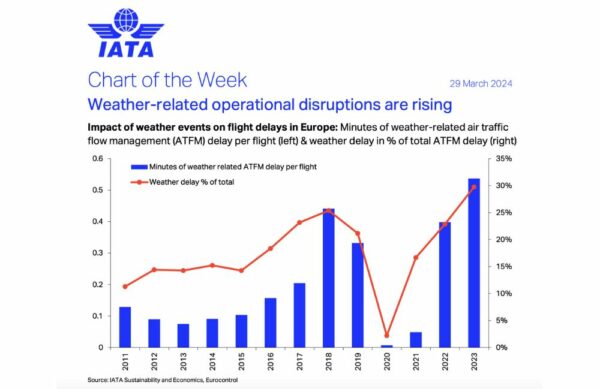TL;DR:
- Weather intelligence transforms airline operations by reducing delays, cancellations, and safety hazards.
- Advanced forecasting technology allows for proactive decision-making and efficient scheduling adjustments.
- Improved customer experience is achieved through better communication and synchronized decision-making during weather disruptions.
- Airlines can save significant costs and enhance operational efficiency by leveraging real-time weather intelligence.
- Despite weather challenges, airlines can effectively manage operations by utilizing cutting-edge weather solutions.
How Does Weather Intelligence Transform Airline Operations in the Aviation Industry?

Irregular Operations (IROPS) in the airline and airport industry caused by disruptive weather events such as snowstorms and lightning pose substantial challenges to the U.S. aviation system.
Understanding Irregular Operations (IROPS)
Irregular Operations (IROPS) are unexpected events that disrupt normal flight operations and schedules, causing delays or cancellations. These can be caused by adverse weather, technical issues, air traffic congestion, crew-related problems, and global events like pandemics. The financial impact is substantial, with over $60 billion in annual losses, passenger dissatisfaction, and operational challenges.
Did you know?
Weather-related flight disruptions have a substantial economic impact on the aviation industry. A study by masFlight revealed that between December 1, 2013, and February 28, 2014, such disruptions cost $5.8 billion, including $5.3 billion in lost passenger activity and $500 million in higher operating costs for airlines.
IATA reports that weather is a significant factor in flight delays and it has been increasing over the years.

1. Weather-Related Flight Disruptions
According to the Bureau of Transportation Statistics (BTS), in the first half of 2024, approximately 21% of flights were delayed, and around 2.5% were canceled. Weather was a significant factor, causing about 30% of these delays (Source: BTS.gov).
According to NOAA, the U.S. experienced 28 separate weather and climate disasters in 2023, each costing at least $1 billion. This was a record number of such events, with a total cost of $92.9 billion
Why?
One of the primary challenges airlines face is the interpretation of weather forecasts.
Current forecasts, often derived from repackaged government data, lack the granularity needed for precise, location-specific, and up-to-the-minute updates essential for anticipating and managing sudden weather events such as lightning and snowstorms within airport flight operations.

Challenges in Interpreting Weather Data
Airlines face challenges interpreting weather forecasts due to:
- Generalized Forecasts: Broad, regional data lacking granularity.
- Delayed Updates: Time lags in updating forecasts.
- Technological Limitations: Lack of integration with real-time data feeds.
- Human Interpretation: Potential for inconsistent decision-making.
What can be done to Mitigate Delays and Cancellations?
By leveraging advanced weather intelligence, airlines can streamline responses to storms without delays in interpreting forecasts. This technology provides timely alerts, allowing airlines to adjust schedules proactively, reducing delays, diversions, and cancellations.
- Real-Time Adjustments: Advanced systems allow immediate updates and scheduling adjustments.
- Cost Efficiency: Optimizing operations with weather intelligence can save hundreds of thousands per hub annually.
- Passenger Satisfaction: Proactive adjustments and improved communication enhance customer trust and loyalty.
2. Managing Safety Hazards During Adverse Weather
Adverse weather conditions like snowfall, ice storms, freezing rain, and strong winds present serious safety challenges for aircraft, affecting both ground operations and inflight phases such as ascent and descent. Unexpected snow accumulation, ice formation on aircraft, and ramp conditions can lead to airport closures and increase safety risks during takeoffs and landings.
How do Airports Manage Safety Hazards?
Airports address safety hazards caused by adverse weather through various strategies:
- Snow Removal: Clearing up to 10,000 tons of snow per hour during severe storms. Learn more about snow removal strategies.
- Anti-Icing Chemicals: Using over 200,000 gallons of deicing fluids in a typical winter season. Discover the role of anti-icing chemicals.
- Timely Deicing: Costs between $1,500 and $3,000 per operation.
- Freezing Rain Management: Specialized equipment and chemicals keep runways safe.
- Strong Winds: Real-time wind data helps manage takeoff and landing operations. Learn about managing strong winds.
3. Minimizing Unnecessary Caution in Airline Operations
Traditional weather forecasts often fail to accurately detect strong winds and lightning, leading to overly cautious measures such as ramp closures, flight cancellations, and overstaffing. This conservatism disrupts operations and inflates costs.
Inaccurate Forecasts:
Imprecise wind forecasts can cause premature ramp closures, resulting in unnecessary downtime and revenue loss. Overly cautious approaches, although intended for safety, can lead to inefficiencies and higher costs.
Operational Inefficiencies:
Increased severe weather events raise operational costs for airlines, including deicing and longer auxiliary power unit (APU) run times. United Airlines notes that these disruptions can decrease revenues and elevate costs.
Economic Impact:
Flight delays and cancellations cost the U.S. airline industry about $30 billion annually. Weather disruptions alone accounted for $5.8 billion in losses, including $5.3 billion from lost passenger activity. Passengers face an average of $383 in extra costs per delay. Additionally, delays contribute to increased carbon emissions, with nine million tons of CO2 released in 2022.
Rise in Weather-Related Disruptions:
IATA reports that weather-related delays have increased from 11% of total delays in 2012 to almost 30% in 2023. The FAA indicates that weather is the largest cause of flight delays, frequently disrupting air travel with severe events like thunderstorms, wind, ice, fog, and snow.
Advanced forecasting technologies reduce weather-related delays by 30%, resulting in fewer cancellations and more reliable service.
By integrating advanced weather intelligence, airlines can enhance efficiency, reduce disruptions, and improve the overall travel experience. For more information, visit Tomorrow.io’s Aviation Solutions.
How did JetBlue save $300k using Weather Intelligence?
4. Addressing Customer Experience Challenges Amid Weather Disruptions
Weather-related flight disruptions have a profound impact on both airlines and their passengers. The FAA estimates that nearly 70% of all delayed or canceled flights are due to weather.
According to AirHelp, passengers face an average additional cost of $383 per person due to delays, including expenses for meals, new flights, and hotel bookings.
The Passenger Perspective
Customer Frustration:
In 2022, around 200 million passengers in the U.S. were affected by flight disruptions; the impact of this is grand.
Brand Loyalty:
US brand loyalty is declining rapidly, and effective management and communication during disruptions are crucial. According to AirHelp, compensation payments by airlines could increase passenger satisfaction by 79%.
How Can Airlines Make The Customer Experience Better?
Proactive Communication:
Keeping passengers informed about potential delays or cancellations in advance helps manage expectations and reduces frustration.
Impact on Customer Loyalty:
Airline International Destination Satisfaction Study found that 40% of participants said a positive customer experience would have a greater impact on their decision to rebook with an airline than a cheaper price.
Use of AI and Data Analysis:
Leveraging AI to analyze customer feedback can lead to targeted improvements in service. This technology helps airlines identify and address customer service issues more effectively.
The Future of Flight: Harnessing Weather Intelligence for Superior Airline Operations
Harnessing the power of weather intelligence is transforming how airlines manage disruptions caused by unpredictable weather. With advanced forecasting technologies, airlines can proactively adjust schedules, reduce delays, and enhance safety. This proactive approach not only cuts costs but also boosts customer satisfaction through improved communication and reliability. As weather-related challenges become more frequent, adopting these innovative solutions will be key to achieving operational excellence and elevating the passenger experience.
Learn More About Advanced Weather Solutions
Weather Intelligence for Airlines and Airports
#JetBlue saved $300k using Weather Intelligence
















